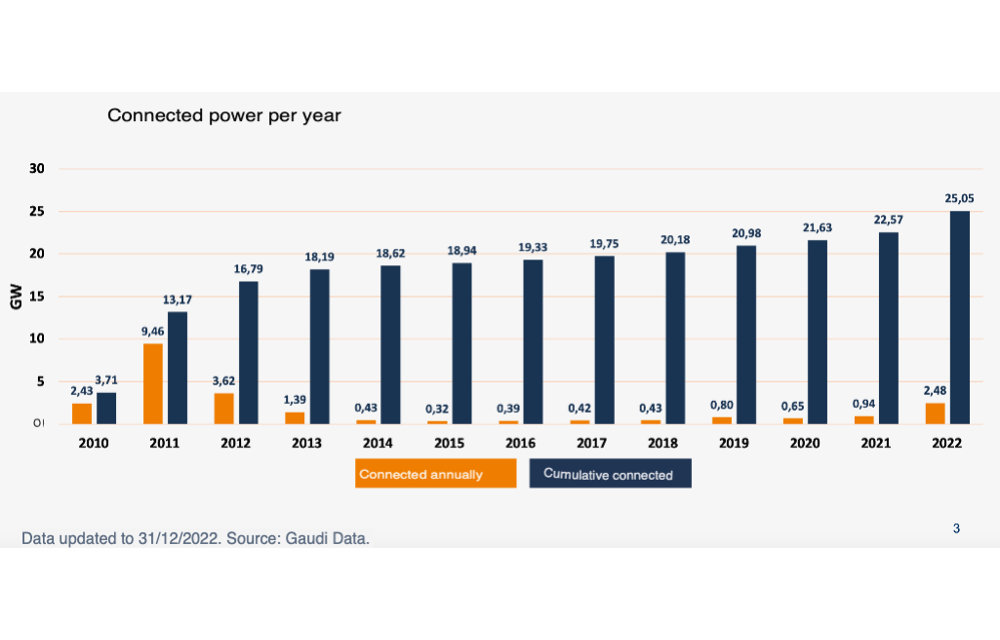- Referring to official statistics from Terna, Italia Solare says Italy installed 2.48 GW new solar in 2022
- It was led by residential segment with 1.1 GW, followed by C&I and utility scale segments with 678 MW and 571 MW, respectively
- Lombardy region has the largest amount of solar installed on cumulative basis adding up to 3.149 GW
Italy closed 2022 with 164% annual improvement in its solar PV installations reporting 2.48 GW vis-à-vis around 940 MW in 2021, taking its cumulative installed PV capacity till the end of last year to 25.05 GW, according to local solar association Italia Solare that refers to official data from Terna to make the claim (see Italy Installed Over 936 MW New Solar).
The residential segment leads aggregate numbers as 87% of 25 GW is made up of systems smaller than 12 kW. These sizes contributed 44% or 1.1 GW of all solar power connected in 2022.
The recent demand for residential segment is attributable to the country’s Superbonus 110 tax relief scheme under which the government deducts 110% of the expenses incurred for energy efficiency of buildings installed from July 1, 2020 to December 31, 2023. It is to be phased out gradually bringing down the deductions to 70% in 2024 and 65% in 2025. Solar and battery storage investments are included in this subsidy scheme.
In 2022, Italy’s commercial and industrial (C&I) sector accounted for 28% or 678 MW with systems ranging between 20 kW and 1 MW, whereas utility scale plants of over 1 MW brought in 23% or 571 MW representing a 467% annual jump. The latter came online in the form of 6×10 MW+ projects.

Another machine translation of Italia Solare’s numbers for the Italian solar market shows Q4/2022 was the quarter with the highest amount of solar capacity installed since Q1/2020. (Source: Italia Solare)
On quarterly basis, the maximum capacity came online in Q4 with 844 MW, up from 627 MW, 634 MW and 377 MW in the 3 preceding quarters respectively, according to the association.
Emilia-Romagna, Veneto and Lombardy regions together accounted for 950 MW PV capacity last year, while Lombardy with a total 3.149 GW led cumulative installations in the country, followed by Puglia at 3.063 GW, and Emilia-Romagna with 2.512 GW.
Yet, the association argues installations need to increase if the country is to achieve its 2030 targets to achieve 55% share of renewables in its total electricity generation.
It explains, “The measures in place are not sufficient and therefore urgent interventions are needed that allow real simplifications, especially for large-scale plants, financial aid to companies for easier access to bank credit, the implementing decrees for the CERs, for the suitable areas and the new market rules, which will also have to facilitate the diffusion of accumulation systems for a more effective penetration of renewables. These are the conditions for being able to reach a minimum target of at least 6 GW of new installations in 2023, which will not yet be what is needed but will mean an important step forward nonetheless.”
Italia Solare’s 2.48 GW annual installation number is close to SolarPower Europe’s (SPE) 2.6 GW forecast in its EU Market Outlook for Solar Power 2022-2026, released in December 2022 (see European Union To Exit 2022 With Over 41 GW Solar Installed). It finally brings Italy back to the GW-level of annual solar installations. However, it is still far off from 9.3 GW the country installed in a single year back in 2011 with uncapped feed-in-tariffs.
As committed under its old National Energy and Climate Plan (NECP), Italy targeted to achieve 51 GW cumulative PV capacity by 2030 which means it would have had to double 2022 capacity in 8 years’ time. However, the country’s new updated target of 71.2 GW by 2030 requires it to nearly triple last year’s annual numbers.
SPE’s analysts believe the country needs to deal with its permitting challenges, in particular for ground-mount systems, to speed up solar deployment along with identifying suitable land for the same and also undertake grid development simultaneously.















